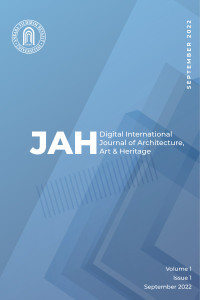Cuban heritage: the architecture of the revolution.
Plaza de la ., ó
Cuban heritage: the architecture of the revolution.
Cuba, Havana, cuban architecture, conservation, heritage, socialism, census 1960-1990 form of expression, Plaza de la Revolución,
___
- Alini, I. (2020). Vittorio Garatti - Opere e progetti. Clean Edizioni, Napoli.
- Azcue, E. (1989). “Plaza de la Revolución”. Arquitectura Cuba, (374), 34 – 49.
- Baroni, S. (1992). “Reporte de La Habana”. Zodiac, (8), 161 – 184.
- Barisone M. & Pozzi N. (2021). Rapporto da La Habana. Indagine sull’Architettura Cubana 1960 – 1990. “Prime ipotesi per Plaza de la Revolución”. [Master Thesis, Politecnico di Torino]. https://webthesis.biblio.polito.it/17173/
- Canella, G. (1992). “Laboratorio Latinoamerica”. Zodiac, (8), 6 – 13.
- Canella, GE. (2006). Architettura di Retroguardia e laboratorio d’oltremare. Per una scuola nazionale di architettura all’Asmara. CLUP, Milano.
- Coyula, M. (2002). Havana: Two Faces of the Antillean Metropolis. The University of North Carolina Press.
- Cuadra, M. (2019a). La arquitectura de la revolución cubana 1959-2018. Kassel University Press, Germany.
- Cuadra, M. (2019b). Aspiraciones y Espacios de una Revòlucion. Kassel University Press, Germany.
- Cuadra, M. (2019c). De primera mano. Entrevistas con sus protagonistas y cronistas. Kassel University Press, Germany.
- Gaceta Oficial De La Republica De Cuba (1977). Edicion ordinaria. La Habana, 6 Agust 1977.
- Garrudo, E. (1978). “Escuela vocacionales”. Arquitectura Cuba, (347 – 348), 42.
- Guevara, E. (1964). “Discurso del dr. Ernesto Guevara en la Clausura del Encuentro de Profesores y Estudiantes”. Arquitectura Cuba, (331), 13 – 14.
- Lapidus, L. (1966). “Ciudad Universitaria J. A. Echeverria”. Arquitectura Cuba, (336), 15 – 16.
- Leal, S. (2011). “El patrimonio cultural cubano y su conservación” available at: https://www.ipscuba.net/ipscuba-net/hemeroteca/archivo-hemeroteca/ck3-cultura-y-sociedad/el-patrimonio-cultural-cubano-y-su-conservacion/ (accessed 07 November 2022).
- Cuba. (1961). Leyes Del Gobierno Revolucionario De Cuba. Finanzas al Dia, Ministerio de Hacienda Talleres de la Imprenta Nacional de Cuba.
- Ley Federal Sobre Monumentos Y Zonas Arqueologicos. Artisticos E Historicos (1972), Diario Oficial, 6 May 1972.
- Niglio, O. (2015). Conservación de centros históricos en Cuba (Volumen I). Aracne Editrice, Roma.
- Portuondo, J. (1966). ”Por una arquitectura cubana y Socialista”. Arquitectura Cuba, (336), 5 – 6.
- Reglamento Para La Ejecución De La Ley 2 De Los Monumentos Nacionales Y Locales (1979). Decreto n° 55, availeble at: https://ru.unesco.org/sites/default/files/cuba_decreto55_spaorof.pdf
- Rodriguez, E. L. (2012). La Arquitectura del Movimiento Moderno Selecion de Obras del Registro Nacional. Edicion Union. Collecion Arquitettura y Ciudad, Cuba – Avana.
- Roig, L. (1963 – 1964). La Habana, apuentes historicos, Consejo nacional de Cultura, Cuba - La Habana. availeble at: https://archive.org/details/EmilioRoigDeLeuchsenringLaHabanaApuntesHistoricosTomoI/page/n7/mode/2up. (accessed 07 November 2022)
- Salinas, F. (1971a). “La escuela revolucionaria como embrion de la comunidad futura”. Arquitectura Cuba, (339), 2 - 4.
- Salinas, F. (1971b). ”La Revolucion en la educacion”. Arquitectura Cuba, (339), 20 – 32.
- Segre, R. (1970). Diez años de arquitectura en Cuba Revoluciónaria. Union, La Habana.
- Segre, R. (1977). L’architettura della Rivoluzione. Marsilio Editori, Venezia.
- Segre, R. (2005). Arquitectura y Urbanismo Modernos, capitalismo y socialismo. Felix Varela, Cuba - Avana.
- Semerani, L. (2001). “Cuba Le scuole nazionali delle arti a L’Avana, Vittorio Garatti, Roberto Gottardi e Riccardo Porro”. IUAV, giornale di istituto (7), 1 – 12.
- Spengler L. (2011). El patrimonio cultural cubano y su conservación, cultura y sociedad. Availeble at: https://revistaconsinter.com/revistas/ano-vi-numero-xi/capitulo-01-direitos-difusos-coletivos-e-individuais-homogeneos/la-proteccion-del-patrimonio-cultural-una-vision-desde-el-derecho-cubano/(accessed 07 November 2022)
- Terraviva Competitions (2022, Nov 7). The Cuban Square a Public Space [r] Evolution in Havana. Terravivacompetitions. Retrieved November 7, 2022, from https://www.terravivacompetitions.com/the-cuban-square-competition-2022/
- Zardoya, L. (2019). La Arquitectura de La Revolución Cubana 1959-2018. Kassel University Press, Germany.
- Başlangıç: 2022
- Yayıncı: Ankara Yıldırım Beyazıt Üniversitesi
Selma HARRİNGTON, Dr. Adi COROVİC, Ahmed OBRALİC
3D Architectural Heritage Platform
Ali Akif YÖRÜK, Muhammed Abdullah BÜLBÜL, Salah HAJISMAIL
Salah HAJISMAIL, Emanuele MOREZZİ, Çevirmen: Salah HAJISMAIL
Çintamani Motifinin 21. Yüzyıl Tezhip Eserlerinde Kullanımı
